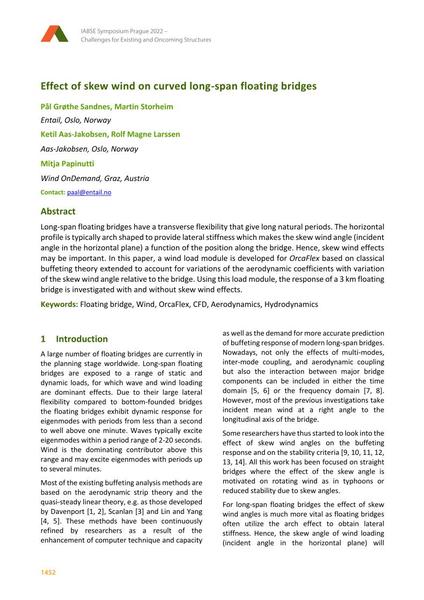Effect of skew wind on curved long-span floating bridges

|
|
|||||||||||
Détails bibliographiques
| Auteur(s): |
Pål Grøthe Sandnes
(Entail, Oslo, Norway)
Martin Storheim (Entail, Oslo, Norway) Ketil Aas-Jakobsen (Aas-Jakobsen, Oslo, Norway) Rolf Magne Larssen (Aas-Jakobsen, Oslo, Norway) Mitja Papinutti (Wind OnDemand, Graz, Austria) |
||||
|---|---|---|---|---|---|
| Médium: | papier de conférence | ||||
| Langue(s): | anglais | ||||
| Conférence: | IABSE Symposium: Challenges for Existing and Oncoming Structures, Prague, Czech Republic, 25-27 May 2022 | ||||
| Publié dans: | IABSE Symposium Prague 2022 | ||||
|
|||||
| Page(s): | 1452-1459 | ||||
| Nombre total de pages (du PDF): | 8 | ||||
| DOI: | 10.2749/prague.2022.1452 | ||||
| Abstrait: |
Long-span floating bridges have a transverse flexibility that give long natural periods. The horizontal profile is typically arch shaped to provide lateral stiffness which makes the skew wind angle (incident angle in the horizontal plane) a function of the position along the bridge. Hence, skew wind effects may be important. In this paper, a wind load module is developed for OrcaFlex based on classical buffeting theory extended to account for variations of the aerodynamic coefficients with variation of the skew wind angle relative to the bridge. Using this load module, the response of a 3 km floating bridge is investigated with and without skew wind effects. |
||||
| Mots-clé: |
vent
|
||||
| Copyright: | © 2022 International Association for Bridge and Structural Engineering (IABSE) | ||||
| License: | Cette oeuvre ne peut être utilisée sans la permission de l'auteur ou détenteur des droits. |
||||
